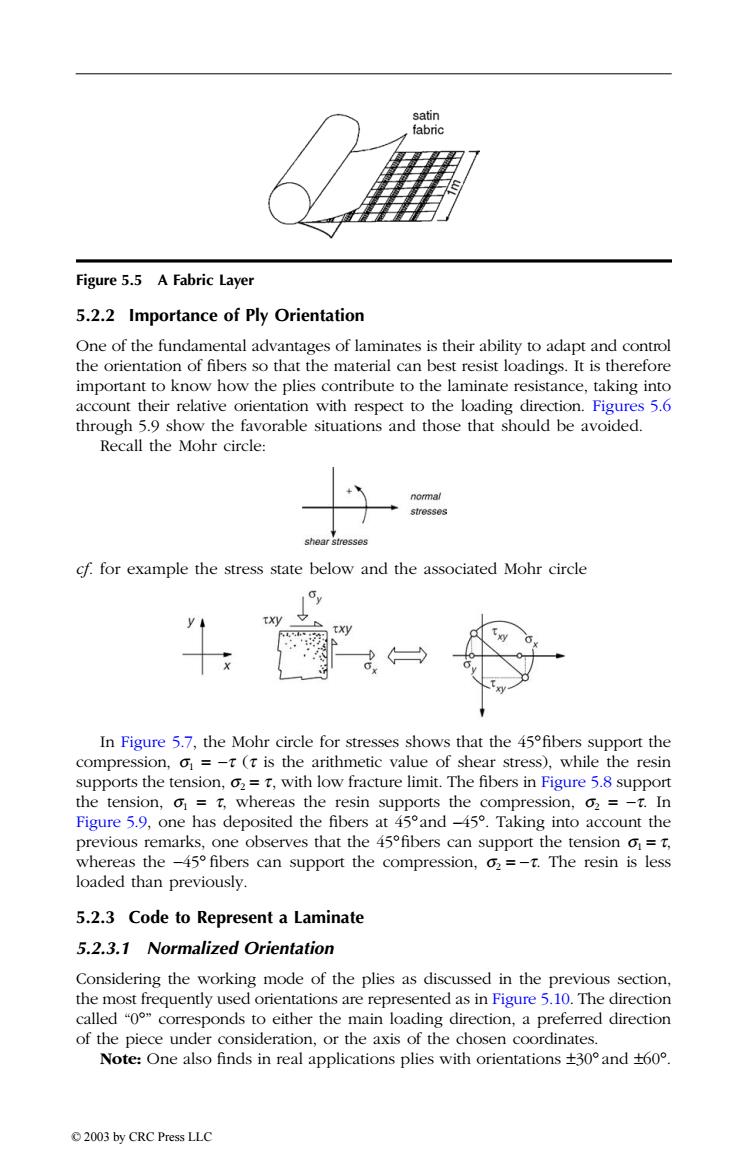正在加载图片...

satin tabnc Figure 5.5 A Fabric Layer 5.2.2 Importance of Ply Orientation One of the fundamental advantages of laminates is their ability to adapt and control the orientation of fibers so that the material can best resist loadings.It is therefore important to know how the plies contribute to the laminate resistance,taking into account their relative orientation with respect to the loading direction.Figures 5.6 through 5.9 show the favorable situations and those that should be avoided. Recall the Mohr circle: normal stresses shear stresses cf.for example the stress state below and the associated Mohr circle Gy In Figure 5.7,the Mohr circle for stresses shows that the 45fibers support the compression,o=-t(t is the arithmetic value of shear stress),while the resin supports the tension,o2=t,with low fracture limit.The fibers in Figure 5.8 support the tension,o=t,whereas the resin supports the compression,o2=-t.In Figure 5.9,one has deposited the fibers at 45and-45.Taking into account the previous remarks,one observes that the 45fibers can support the tension o=t, whereas the -45 fibers can support the compression,02=-t.The resin is less loaded than previously. 5.2.3 Code to Represent a Laminate 5.2.3.1 Normalized Orientation Considering the working mode of the plies as discussed in the previous section, the most frequently used orientations are represented as in Figure 5.10.The direction called "0"corresponds to either the main loading direction,a preferred direction of the piece under consideration,or the axis of the chosen coordinates. Note:One also finds in real applications plies with orientations +30 and +60. 2003 by CRC Press LLC5.2.2 Importance of Ply Orientation One of the fundamental advantages of laminates is their ability to adapt and control the orientation of fibers so that the material can best resist loadings. It is therefore important to know how the plies contribute to the laminate resistance, taking into account their relative orientation with respect to the loading direction. Figures 5.6 through 5.9 show the favorable situations and those that should be avoided. Recall the Mohr circle: cf. for example the stress state below and the associated Mohr circle In Figure 5.7, the Mohr circle for stresses shows that the 45∞fibers support the compression, s1 = -t (t is the arithmetic value of shear stress), while the resin supports the tension, s2 = t, with low fracture limit. The fibers in Figure 5.8 support the tension, s1 = t, whereas the resin supports the compression, s2 = -t. In Figure 5.9, one has deposited the fibers at 45∞and –45∞. Taking into account the previous remarks, one observes that the 45∞fibers can support the tension s1 = t, whereas the -45∞ fibers can support the compression, s2 = -t. The resin is less loaded than previously. 5.2.3 Code to Represent a Laminate 5.2.3.1 Normalized Orientation Considering the working mode of the plies as discussed in the previous section, the most frequently used orientations are represented as in Figure 5.10. The direction called “0∞” corresponds to either the main loading direction, a preferred direction of the piece under consideration, or the axis of the chosen coordinates. Note: One also finds in real applications plies with orientations ±30∞ and ±60∞. Figure 5.5 A Fabric Layer TX846_Frame_C05 Page 73 Monday, November 18, 2002 12:09 PM © 2003 by CRC Press LLC